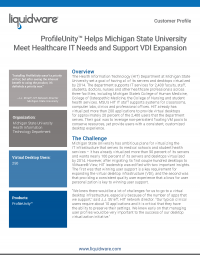Liquidware ProfileUnity Helps MSU's HIT Department Achieve HIPAA Compliance
The Health Information Technology (HIT) Department at Michigan State University supports IT services for 2,400 faculty, staff, students, doctors, nurses and other healthcare professionals across three facilities that are home to the College of Human Medicine, College of Osteopathic Medicine, the College of Nursing and Student Health Services. HIT needs to support more than 200 applications across this diverse set of users – no easy task. This issue, combined with other drivers, which included a "greener" approach to conserving resources, upgrading the user experience on desktops, and achieving HIPAA compliance, led MSU's HIT team to launch virtual desktops.
A key requirement for the HIT team was that the virtual desktops offer consistent user personalization and continuity of experience. After a failed experiment with persistent desktops – which became bloated and corrupted over time, the HIT staff turned to non-persistent, stateless desktops with the user environment managed by Liquidware ProfileUnity. The solution not only solved the problem of providing user profiles upon login to keep desktops consistent, MSU's HIT Department also met several other critical objectives with this approach:
- The organization achieved compliance with HIPAA rules requiring that patient data be secured, and when shared, must be sent over an encrypted connection. The new virtual desktop environment, with ProfileUnity managing user profiles and securing user-authored data in a central data store, helped meet these requirements. In addition, ProfileUnity's User Environment Management advanced features also helped staff lock down desktops, restricting access as required.
- Workspace access from a diversity of devices was enabled, because ProfileUnity does not require an agent on client machines.
- Virtual desktops allow HIT to continue to run older applications alongside newer versions on newer OSes, including Windows 7 and beyond. This is significant, because healthcare organizations traditionally have a pattern of running legacy applications, as it is not always easy to port these over to newer systems.

